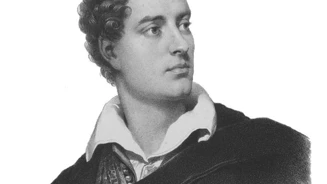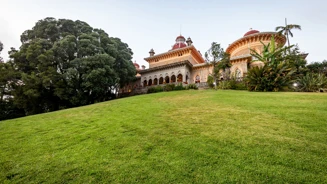Monserrate, the ‘fairy dwelling’ that inspired one of the greatest English writers
17 Mar 2025
Who could resist Monserrate, its beauty, its grandeur? In the early 19th century, the existing property bore little or no resemblance to what we find there today, but, even so, it attracted the attention of many people – some better known than others.
Lord Byron, one of the most influential figures of European Romanticism, was one of those who allowed Monserrate to cast its spell on him. It all began with a journey around Europe, which Byron – born in London in 1788 – undertook in order to discover the charms of the old continent, passing through Spain, Italy, Malta and Greece, and, of course, Portugal. During those two years of travelling – 1809 to 1811 – he absorbed different cultures, different customs, different landscapes and different inspirations.
It was this journey that gave rise to Childe Harold’s Pilgrimage, one of his best known works and a resounding success in its day. In this narrative poem, published in 1812, Byron describes the journey of a man seeking new meaning for his life in foreign lands. One of the places mentioned – and highly praised – in the work is Sintra. In Canto I, Lord Byron describes it as a ‘glorious Eden,’ a ‘maze of mount and glen,’ ‘more dazzling unto mortal ken’ than that of which the poets speak.
“Poor, paltry slaves! yet born midst noblest scenes /
Why, Nature, waste thy wonders on such men? /
Lo! Cintra's glorious Eden intervenes /
In variegated maze of mount and glen./
Ah me! what hand can pencil guide, or pen, /
To follow half on which the eye dilates /
Through views more dazzling unto mortal ken /
Than those whereof such things the bard relates, /
Who to the awe-struck world unlocked Elysium's gates?”
Byron makes reference to ‘our Lady’s house of woe’ (the Monastery of Nossa Senhora da Pena), which was later bought by King Fernando II, who built there, using his personal fortune, his refuge in the Sintra Hills: the Park and Palace of Pena. His description of a ‘toppling convent’ is apt given that, at that time, following the earthquake of 1755, the monastery that stood there – built at the order of King Manuel I – was practically in ruins.
“The horrid crags, by toppling convent crowned, /
The cork-trees hoar that clothe the shaggy steep, /
The mountain moss by scorching skies imbrowned, /´
The sunken glen, whose sunless shrubs must weep, /
The tender azure of the unruffled deep,
/ The orange tints that gild the greenest bough,
/ The torrents that from cliff to valley leap,
/ The vine on high, the willow branch below,
/ Mixed in one mighty scene, with varied beauty glow”

But one of the places that made the greatest impression on Lord Byron was Monserrate, not for the striking building, but for the natural, if rather abandoned, beauty of its setting. Monserrate at that time bore little or no resemblance to the monument we know today. The chain of events was as follows: in 1789, the British merchant Gerard de Visme became the tenant of the property, which belonged to the Melo e Castro family. He ordered the construction of a neo-Gothic building, but in 1794 returned to England and sublet Monserrate to William Beckford, a well-known English aristocrat, writer, critic and politician. Beckford lived there only until 1796, allowing the property to gradually fall into decay. While this was happening in Portugal, however, Beckford was constructing a striking building in England – Fonthill Abbey – demonstrating the raison d’être of the ‘richest commoner in England,’ as he was described by the newspapers.
In 1809, when he visited Monserrate, Lord Byron was impressed by what he saw – one of the most powerful men in his country had a beautiful property, in one of the most stunning locations in the world, completely in ruins. Without mentioning Monserrate, and referring to Beckford as Vathek (the title of his most famous novel), Byron speaks of ‘ruin’d splendour,’ in a ‘fairy dwelling’ as lone as Beckford himself.
“On sloping mounds, or in the vale beneath, /
Are domes where whilom kings did make repair; /
But now the wild flowers round them only breathe: /
Yet ruined splendour still is lingering there. /
And yonder towers the prince's palace fair: /
There thou, too, Vathek! England's wealthiest son, /
Once formed thy Paradise, as not aware /
When wanton Wealth her mightiest deeds hath done, /
Meek Peace voluptuous lures was ever wont to shun.
Here didst thou dwell, here schemes of pleasure plan. /
Beneath yon mountain's ever beauteous brow; /
But now, as if a thing unblest by man, /
Thy fairy dwelling is as lone as thou! /
Here giant weeds a passage scarce allow /
To halls deserted, portals gaping wide; /
Fresh lessons to the thinking bosom, how /
Vain are the pleasaunces on earth supplied; /
Swept into wrecks anon by Time's ungentle tide.”
Childe Harold’s Pilgrimage is, above all, a symbol of British Romantic literature, but it is also, in part, a tribute to Sintra, that small Portuguese ‘Eden.’

